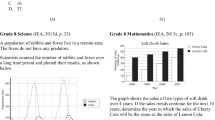
Overview
- Enables researchers and policymakers to track student performance in mathematics and physics over time at three grade levels
- Provides in-depth information about students' level of understanding and misconceptions across a range of core concepts
- Identifies common student misconceptions and misunderstandings, enabling policymakers to target areas for curriculum improvement
- Enables teachers to plan for and provide additional critical support to their students on common misconceptions or errors in mathematics and physics
Part of the book series: IEA Research for Education (IEAR, volume 9)
Buy print copy
Tax calculation will be finalised at checkout
About this book
This open access report explores the nature and extent of students’ misconceptions and misunderstandings related to core concepts in physics and mathematics and physics across grades four, eight and 12. Twenty years of data from the IEA’s Trends in International Mathematics and Science Study (TIMSS) and TIMSS Advanced assessments are analyzed, specifically for five countries (Italy, Norway, Russian Federation, Slovenia, and the United States) who participated in all or almost all TIMSS and TIMSS Advanced assessments between 1995 and 2015.
The report focuses on students’ understandings related to gravitational force in physics and linear equations in mathematics. It identifies some specific misconceptions, errors, and misunderstandings demonstrated by the TIMSS Advanced grade 12 students for these core concepts, and shows how these can be traced back to poor foundational development of these concepts in earlier grades. Patterns in misconceptions and misunderstandings are reportedby grade, country, and gender. In addition, specific misconceptions and misunderstandings are tracked over time, using trend items administered in multiple assessment cycles.
The study and associated methodology may enable education systems to help identify specific needs in the curriculum, improve inform instruction across grades and also raise possibilities for future TIMSS assessment design and reporting that may provide more diagnostic outcomes.
Similar content being viewed by others
Keywords
- IEA
- Large-scale studies in education
- Open access
- Science misunderstandings
- Mathematics misunderstandings
- TIMSS
- Student performance
- Core concepts in mathematics and physics
- Foundational development of core concepts
- Item-level performance data
- Improving teaching and learning
- STEM Education
- Curriculum improvement
- Large-scale assessments in science and mathematics
- Patterns in misconceptions, errors, and misunderstandings
Table of contents (5 chapters)
-
Front Matter
-
Back Matter
Authors and Affiliations
Bibliographic Information
Book Title: Student Misconceptions and Errors in Physics and Mathematics
Book Subtitle: Exploring Data from TIMSS and TIMSS Advanced
Authors: Teresa Neidorf, Alka Arora, Ebru Erberber, Yemurai Tsokodayi, Thanh Mai
Series Title: IEA Research for Education
DOI: https://doi.org/10.1007/978-3-030-30188-0
Publisher: Springer Cham
eBook Packages: Education, Education (R0)
Copyright Information: International Association for the Evaluation of Educational Achievement (IEA) 2020
Hardcover ISBN: 978-3-030-30187-3Published: 05 November 2019
Softcover ISBN: 978-3-030-30190-3Published: 11 September 2020
eBook ISBN: 978-3-030-30188-0Published: 30 October 2019
Series ISSN: 2366-1631
Series E-ISSN: 2366-164X
Edition Number: 1
Number of Pages: IX, 165
Number of Illustrations: 98 b/w illustrations, 1 illustrations in colour
Topics: International and Comparative Education, Assessment, Testing and Evaluation, Science Education, Mathematics, general, Physics, general



